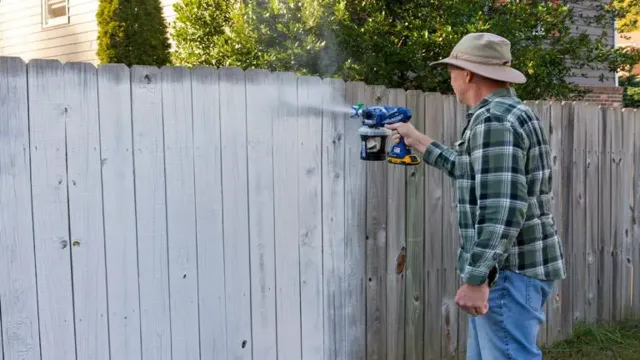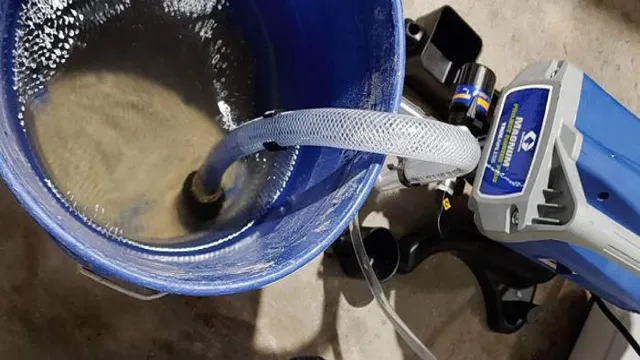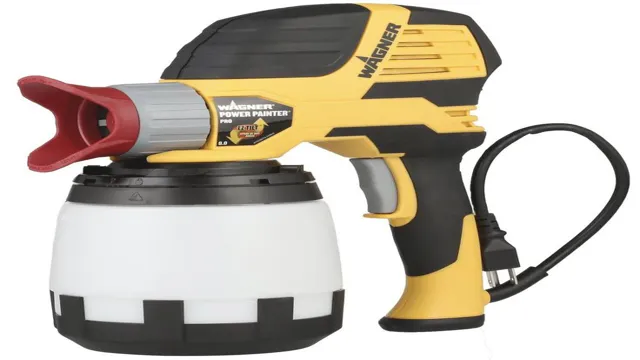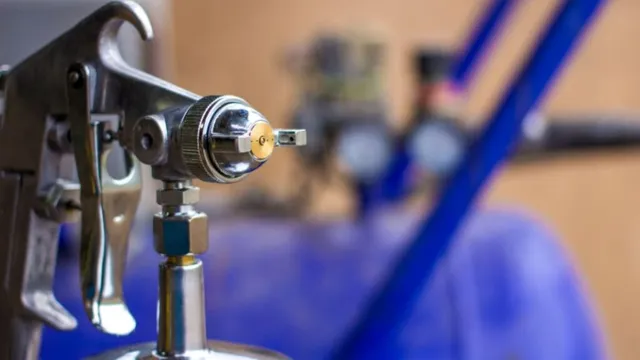Can You Run Stain Through a Paint Sprayer? Our Comprehensive Guide.

Are you thinking about spraying stain through a paint sprayer for your next home improvement project? It can be a cost-effective and efficient way to stain large surfaces like decks, fences, and siding. But before you grab your sprayer, there are a few things to consider. First, not all sprayers are created equal.
You’ll want to look for a sprayer specifically designed for staining, as it will have the proper nozzle and viscosity settings to ensure an even and consistent application. Also, make sure to choose a sprayer with ample power, as stains can be thicker than paint and require more pressure to atomize properly. Another factor to consider is the weather.
Staining should be done in mild temperatures (ideally between 50-85°F) with low humidity and no rain in the forecast. This allows for the stain to dry properly and prevents it from washing away or forming mildew. Proper preparation is key when using a paint sprayer for staining.
Take the time to clean and sand the surface to be stained, and cover any surrounding areas with protective plastic or tape. It’s also important to wear protective gear like gloves, goggles, and a respirator to avoid inhaling harmful fumes. Finally, practice makes perfect! Before tackling a large project, do a test run on a small, inconspicuous area to get a feel for how the sprayer operates and adjust the settings as needed.
Overall, spraying stain through a paint sprayer can be a game-changer for your staining projects. Just be sure to do your research, prep properly, and practice before diving in.
Introduction
If you are wondering if you can run stain through a paint sprayer, the answer is yes, you can! In fact, using a paint sprayer for staining can save you time and effort. However, there are a few things to keep in mind before you start spraying stain with your paint sprayer. Firstly, make sure that the sprayer is clean and free of any paint residue in the system.
Secondly, check the viscosity of the stain and thin it if necessary to ensure proper atomization. It is also important to use the correct tip size for the thickness of the stain, and to adjust the pressure to achieve the desired coverage and finish. With these considerations in mind, you can successfully run stain through a paint sprayer and achieve a smooth, even finish with minimal effort.
Understanding the Compatibility of Stain and Sprayers
Stain and sprayers are two essential components in the painting process, but their compatibility is often overlooked. It’s important to understand how they work together to achieve the desired results. When choosing a sprayer, it’s crucial to consider the type of stain you will be using.
Different stains require different types of sprayers, and using the wrong one can result in a subpar finish. For instance, water-based stains require sprayers that can handle thinner paint products, while oil-based stains require more powerful sprayers that can handle thicker coatings. Understanding the compatibility between your chosen stain and sprayer will save you time and money while ensuring that your project is completed to your satisfaction.
So, next time you’re planning a painting project, remember to take into account the stain and sprayer compatibility to achieve the perfect finish.

Advantages of Spraying Stain Through a Paint Sprayer
Spraying stain through a paint sprayer has become increasingly popular among DIY enthusiasts and professionals alike. One of the main advantages of using a paint sprayer to apply stain is the speed and efficiency it offers. The sprayer can cover a large area quickly and evenly, ensuring a consistent finish.
Additionally, using a sprayer allows for a more controlled application, resulting in less wasted material and saving both time and money. Moreover, the sprayer can reach tight corners and difficult-to-reach areas with ease, making it ideal for intricate projects. Overall, by using a paint sprayer to apply stain, you can achieve a smooth and flawless finish in a fraction of the time it would take to apply by hand, making it a cost-effective and time-saving solution for any project.
Steps to Run Stain Through a Paint Sprayer
Yes, you can definitely run stain through a paint sprayer. However, there are a few important steps that you should follow to ensure that everything goes smoothly. First and foremost, make sure that you have the right type of sprayer for the job.
Paint sprayers can usually handle both paint and stain, but it’s important to choose the right one for the specific type of stain that you’re using. Next, you’ll need to properly prepare the surfaces that you’ll be staining. This may include sanding, cleaning, and possibly even applying a primer or sealant.
Once everything is prepped, you’ll want to make sure that your sprayer is set up correctly and that you’re using the right nozzle and tip for the particular stain that you’re using. Finally, practice your technique and start spraying slowly and evenly, making sure to cover all areas and keep an eye out for any drips or uneven spots. With these steps in mind, you can successfully run stain through a paint sprayer and achieve professional-looking results.
Preparation
Preparing to run stain through a paint sprayer is crucial to ensure that the process runs smoothly and produces the desired results. The first step is to gather all the necessary materials: stain, paint sprayer, paint strainer, paint thinner, and a clean container. It’s also important to wear protective gear, such as gloves, goggles, and a respirator mask, to prevent exposure to harmful chemicals.
Before running the stain through the sprayer, it’s crucial to make sure that the sprayer is clean and free of any leftover paint residue. This can be achieved by using a cleaning solution specifically designed for paint sprayers. After cleaning the sprayer, it’s recommended to perform a test spray on a piece of cardboard to ensure that the stain is spraying evenly without any clogs or drips.
By following these steps, you can ensure that your stain will be applied evenly and smoothly with minimal mess or fuss.
Thin the Stain
If you’re planning to use a paint sprayer to apply stain to your surfaces, it’s essential to prepare the stain correctly before pouring it into the sprayer. By thinning the stain, you can ensure that it flows smoothly through the spray nozzle without creating clogs or drips. To thin your stain, you’ll need to mix it with the right amount of mineral spirits or water, depending on the type of stain you’re using.
It’s crucial to follow the manufacturer’s instructions carefully to achieve the right consistency and avoid damage to your sprayer. Once you’ve thinned your stain, test it on a small area first to ensure that it sprays evenly and dries without streaking or clumping. With these steps, you can ensure that your stain is ready to be applied through your paint sprayer for a smooth and flawless finish.
Fill the Sprayer with Stain
One of the most efficient ways to apply stain is by using a paint sprayer. However, before you start, make sure to read the manufacturer’s instructions to ensure that your paint sprayer is suitable for use with stain. After that, start by filling the sprayer with your chosen stain.
Make sure to pour the stain through a strainer to remove any lumps or debris that could clog your sprayer. Next, attach the spray gun to the sprayer and turn it on. Adjust the air pressure and pattern to your liking.
Spray parallel to the surface, moving the gun smoothly and steadily. Remember to keep the gun a consistent distance from the surface to avoid overspraying. Once you’ve finished spraying, flush the sprayer with solvent to remove any remaining stain and prevent blockages.
By following these steps, you’ll be able to run stain through a paint sprayer efficiently and achieve a smooth finish with minimal effort.
Test the Sprayer
If you plan to run stain through a paint sprayer, there are essential steps to ensure a successful outcome. Before you begin, make sure to test the sprayer to determine the appropriate pressure settings and ensure it is working properly. Begin by filling the sprayer with the desired stain and thinning it according to the manufacturer’s instructions.
Next, adjust the spray nozzle to the desired pattern and test the sprayer on a small surface to check for even coverage. As you continue, maintain a consistent distance between the sprayer and the surface and use smooth, overlapping strokes. Always remember to clean the sprayer thoroughly after each use to keep it in excellent working condition.
With these steps in mind, you’ll be on your way to achieving a professional-looking finish on your projects.
Spraying the Stain
When it comes to staining, most people assume that it’s a job best done with a brush or roller. However, spraying the stain can actually save you time and effort while still yielding great results. The first step in this process is to choose the right type of paint sprayer- ideally, you want one that has an adjustable nozzle so you can control the flow of the stain.
Before you start spraying, make sure to protect any nearby surfaces that you don’t want to get stain on. Once you’re ready to go, test out the sprayer on a scrap piece of wood to make sure that the stain is coming through at the right consistency. If everything looks good, you can start spraying! Hold the sprayer about 6-8 inches away from the surface and keep the nozzle moving at a steady pace to ensure even coverage.
Don’t worry if it looks a little uneven at first- you can always go back over any missed spots after the first coat dries. When you’re done, clean out the sprayer thoroughly to prevent any clogs or buildup. With a little practice, spraying your stain can be a quick and easy way to get a gorgeous finish on your woodworking projects.
Conclusion and Tips for Staining with a Sprayer
In conclusion, while it may be tempting to try and cut corners by running stain through a paint sprayer, it’s important to remember that just because they both involve liquid and a spraying mechanism, does not mean they are interchangeable. So, unless you want your once beautiful wood finish to end up looking like a Jackson Pollock painting, stick to using the appropriate tool for the job. Your furniture will thank you for it!”
FAQs
What happens if I run stain through a paint sprayer?
It is not recommended to run stain through a paint sprayer as it can clog the sprayer and cause damage. Use a separate sprayer designated for stain instead.
Can I use the same paint sprayer for stain and paint?
While some sprayers may claim to work for both, it is generally recommended to use separate sprayers for stain and paint to avoid clogging and ensure proper application.
Are there any specific sprayers designed for staining?
Yes, there are sprayers specifically designed for staining that offer finer control and better atomization for a smoother finish. Look for sprayers labeled as “HVLP” or “airless” for best results.
Can I thin out my stain to make it work with a paint sprayer?
While you can technically thin out your stain to make it more compatible with a paint sprayer, doing so can affect its color and consistency. It is recommended to use a separate sprayer for stain instead.
How do I clean my paint sprayer after using it for stain?
Follow the manufacturer’s instructions for cleaning your paint sprayer after use, taking extra care to remove any residual stain that may cause clogs or damage. Use a cleaning solution recommended for the specific type of sprayer you have.
What type of stain should I use with a paint sprayer?
Most types of stain can be used with a paint sprayer, but water-based stains are generally easier to work with and clean up than oil-based stains.
What are some tips for using a paint sprayer with stain?
Make sure to strain your stain before using it to remove any solids or debris that could cause clogs. Test your sprayer on a small, inconspicuous area first to ensure proper application. Use a low-pressure setting and keep the sprayer moving at a consistent pace to avoid over-applying or creating runs.



